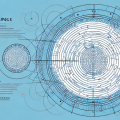The unit circle is a mathematical tool used to understand angles and calculate trigonometric functions. It is an ubiquitous tool used in mathematics, engineering, and physics to solve complex problems. In this article, we will explore the unit circle in detail, covering everything from its geometry and application to visualizing its 3D form. Let’s get started!
What is the Unit Circle?
Simply put, the unit circle is a circle with radius 1 centered at the origin. This circle is used to measure angles in radians rather than degrees. Measuring angles in radians (one radian is equal to the angle created by a circle’s radius) allows us to express trigonometric values more accurately than with degrees. The x-axis intersects the unit circle at 0 radians (or 0°), while the y-axis intersects the unit circle at π/2 radians (or 90°). The unit circle can also be used to graph polar coordinates and complex numbers.
The Geometry of the Unit Circle
The geometry of the unit circle is based on the Pythagorean Theorem. The radius of the unit circle is equal to 1 and its circumference is equal to 2π. If you draw a line from any given point on the circle, perpendicular to the x and y-axis, then the two sides of that line, can be used to solve a right triangle and calculate the values of trigonometric functions. For example, if you draw a line that intersects the x-axis at x = 1, then the length of the side perpendicular to y-axis (from the point of intersection to the point on the unit circle) is equal to sin(1). Similarly, this theorem can be used to calculate cosine, tangent and all other common trigonometric functions.
Understanding the Radian Measurement System
As mentioned, angles on a unit circle are measured using radians, rather than degrees. A full circle consists of 2π radians, or 360°. Each radian can also be expressed as a fraction of a circle, for example, 1/4 of a circle is equal to π/2 radians (or 90°). To convert from degrees to radians, simply calculate degree*π/180. Similarly, to convert from radians to degrees, calculate radians*180/π.
Trigonometric Values of the Unit Circle
Using the geometry of the unit circle, we can calculate all common trigonometric values. As mentioned above, given a line that intersects the x-axis at x = 1, then the length of the side perpendicular to y-axis (from the point of intersection to the point on the unit circle) is equal to sin(1). Similarly, cosine is equal to x (x being the value at which the line intersects the x-axis). If the point intercepted by the line is the origin, then tan(0) is equal to 0.
Plotting Points on the Unit Circle
Plotting points on a unit circle is as simple as finding their coordinates. The coordinates for any given point on a unit circle can be found by using trigonometry. For instance, given angle θ, then its coordinates (x, y) will be (cos(θ), sin(θ)). This is because sine is equal to y, and cosine is equal to x for any angle on a unit circle.
Visualizing the Unit Circle in 3 Dimensions
When visualized in three dimensions, we can see that a unit circle is actually part of a sphere — one quarter of a sphere in fact. This is because a full circle equals 2π or 360°, while one quarter of a sphere equals 1π or 90°. In three dimensions we can also graph complex numbers — this further demonstrates how useful a tool the unit circle is.
Applications of the Unit Circle in Math and Science
The unit circle can be used in mathematics and science to solve equations and find values for various functions. In mathematics it can be used for trigonometric calculations such as finding angles and lengths, solving triangle problems and graphing curves. In physics formulas involving rotational motion are based on angles measured using radians — this makes using a unit circle essential for solving complex physics problems.
Working with Complex Numbers and the Unit Circle
The unit circle can also be used to represent complex numbers — these are simply numbers with real and imaginary components. When graphed on a unit circle, we can easily compare the magnitudes and phase shifts of two numbers. As expected, when graphed in three dimensions it incrementally gets more difficult to visualize.
Working with Polar Coordinates and the Unit Circle
The final application of a unit circle worth mentioning is working with polar coordinates. Polar coordinates are based on angles measured using radians rather than degrees — this is yet another way in which a unit circle can be extremely helpful. We can use polar coordinates to graph circles and more complex curves such as ellipses and parabolas.
We hope this article has helped you get a detailed picture of what a unit circle is and its myriad applications in mathematics and science. Thanks for reading!





